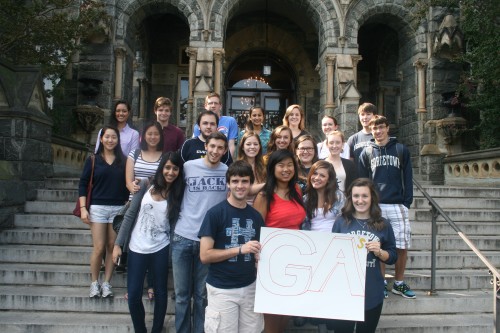This article is part of the NAIMUN Featured Series in preparation for NAIMUN 50 and was written by Brian Monahan and Ashley Lozier.
Bringing GAs into the 21st century:
The use of technology to create exciting and interactive committees
As the largest organ of NAIMUN, the General Assemblies (GAs) consistently boast the highest number of delegates, with over 1,600 high school students participating in traditional committees such as the First Committee on Disarmament and International Security (DISEC) and the Third Committee on Social, Humanitarian and Cultural Affairs (SOCHUM). However, the GA’s of NAIMUN 50 will also feature historical committees such as Russian Duma 1906 and Political and Security Council (POLISEC), 1963. With each committee consisting of approximately 230 delegates, GA’s face unique challenges in keeping such a large number of students engaged. As Undersecretary General (USG) and Deputy Undersecretary General (dUSG), we are faced with the task of facilitating the participation of as many delegates as possible throughout the conference. Given a limited amount of speaking time, we seek to implement other avenues for student expression and participation in committee in order to ensure that every delegate has a meaningful, educational, and engaging experience. Using social media, including live twitter updates, encourages delegates to participate in the real-time happenings of committee, while technology, such as Google Drive, allows committees to share information and research. This ultimately keeps all staffers, from Chairs to Rapporteurs, on the same page regarding committee preparation while at the same time leading to a more organized, engaging experience for delegates and staffers alike.
The first challenge we encountered as USG and dUSG was the reality of individuals joining NAIMUN staff at different times during pre-conference preparation. This challenge even rose all the way to the top of our organ when a new dUSG was selected in the fall of 2012 after a staffing vacancy over the summer. This, along with almost half the organ staff joining in the fall before the conference, led to a communication crisis: how to best keep everyone on the same page and integrate everyone quickly into the organ. Our answer arose in Google Drive, a database similar to Dropbox, that directly links with everyone’s Gmail accounts. Staffers were encouraged to utilize Drive to upload background guide outlines and to communicate with the rest of their committee staff. Furthermore, on the USG-dUSG end, we utilized Drive to keep a spreadsheet of all committee requirements so that staffers could check and see when certain items were due and if we had received certain items from them. This was especially useful in one of our committees in which both Chairs were abroad for the fall semester. Using Drive helped to keep them and the rest of their committee on the same page even when no face-to-face interactions were possible. In fact, they were the first committee to submit their background guide. Another result of using these methods for preconference preparation was an increase in overall general staff morale. Many general staffers who would not normally be able to work on, understand, and participate more fully in the background guide writing process were given a chance to do so. This will doubtlessly pay off during the in-conference committee sessions, with each staffer invested in, engaged with, and excited for their committee.
Recent studies have shown that approximately ninety percent of high school students utilize social media in one form or anther. The usage social media to enhance committee participation has proved to be a successful step towards bringing NAIMUN into the 21st century. Twitter in particular, a platform that allows for frequent in-committee updates, as well as informal debate, has been especially useful in giving delegates up-to-the-minute news and reactions to committee happenings. This technology plays an important role in helping Chairs and Directors of GAs solve the common problem of reaching the “back of the room.” In large committees, it can often be difficult to ensure that all delegates stay on the same page regarding new ideas and debates surfacing in committee. A live twitter feed, monitored by staff members, has allowed for informal discussion, leading to more cohesive, meaningful committee sessions for all delegates. As delegates submit tweets, a rapporteur screens and submits them to the live feed. This setup allows delegates the option to debate in two ways, the first being through formal debate and the second being through debates over Twitter. Delegates also take advantage of opportunities to strategize over social media. Aside from Twitter, Facebook also holds potential to be a useful tool for GAs. We are looking to implement General Assemblies Facebook groups this year, monitored by staffers, to allow for delegates to meet one another, facilitate substantive meetings outside of committee, and possibly even to allow for debate over another social media platform outside of committee. Such debate could provide an interesting committee dynamic and allow for the participation of as many students as possible. Social media platforms, like Facebook and Twitter, keep the General Assemblies up to date with current technology and have become an excellent way for committees to run both physically and virtually at the same time.
We have seen that using technology in running a large organ such as GAs makes communication and organization much easier. We have benefited especially in the preconference planning aspect of running an organ and hope to see this translate to equally successful in-conference debate. We hope that our successors next year will continue to implement technology in GAs to further improve the caucus experience and also continue to keep NAIMUN on the cutting edge of Model UN experiences. All in all, technology has been a great tool and resource for us to more effectively do our jobs as USG and dUSG and hopefully will allow for delegates in our organ to have a more interactive, engaging, and better overall experience at NAIMUN 50.
Hoya Saxa!
Brian Monahan
USG of General Assemblies NAIMUN L
Ashley Lozier
dUSG of General Assemblies NAIMUN L



